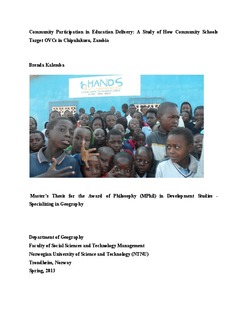| dc.contributor.advisor | Lund, Ragnhild | nb_NO |
| dc.contributor.author | Kalemba, Brenda | nb_NO |
| dc.date.accessioned | 2014-12-19T14:26:30Z | |
| dc.date.available | 2014-12-19T14:26:30Z | |
| dc.date.created | 2013-10-10 | nb_NO |
| dc.date.issued | 2013 | nb_NO |
| dc.identifier | 655134 | nb_NO |
| dc.identifier.uri | http://hdl.handle.net/11250/265561 | |
| dc.description.abstract | In recent years, the importance of education as a catalyst for personal, social and economic development has gained much recognition. This is evident from global commitments towards UPE at the world education declaration on EFA in 1991 as well as being the second MDG to be attained world over by 2015. In most developing countries, such recognition has increased the demand for education particularly primary schooling. However, high poverty levels and the impact of HIV/AIDS pandemic still deny many children access to primary education. In order to cater for those who are excluded, there has been an increased advocacy for community participation in education delivery. This has also helped to spread education costs among the stakeholders. However, most urban slum areas in Zambia still face inadequate education facilities. This has resulted into the growing number of community schools which target OVCs. The OVCs are mostly excluded from state schooling due to inability of their parents or guardians to meet some ‘hidden’ financial costs in government basic schools. The main objective was to find out how community schools targeted OVCs and provided them with primary education.
By using a qualitative approach to research enquiry, three community schools in Chipulukusu compound are examined for this purpose. The study’s results show that through a participatory approach to education delivery, community schools delivered education to the OVCs despite their many challenges such as having fewer and untrained teachers, inadequate financial resources, limited teaching and learning materials. This study also notes that community schools’ interventions were perceived differently by various stakeholders indicating a diversity of interests among different stakeholders. None the less, the results actually showed that community schools had increased access to primary education and put the country on a right track towards achieving MDG 2. Hence community schools present a model worth emulating. | nb_NO |
| dc.language | eng | nb_NO |
| dc.publisher | Norges teknisk-naturvitenskapelige universitet, Fakultet for samfunnsvitenskap og teknologiledelse, Geografisk institutt | nb_NO |
| dc.title | Community Participation in Education Delivery: A Study of How Community Schools Target OVCs in Chipulukusu, Zambia | nb_NO |
| dc.type | Master thesis | nb_NO |
| dc.contributor.department | Norges teknisk-naturvitenskapelige universitet, Fakultet for samfunnsvitenskap og teknologiledelse, Geografisk institutt | nb_NO |
